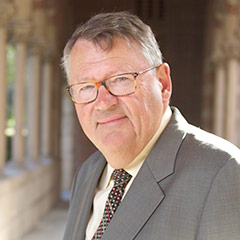There have been a number of powerful long-term music collaborations over the years in many musical styles: Rogers and Hammerstein, George and Ira Gershwin, the Beatles, Gilbert and Sullivan, Simon and Garfunkel - often involving words and music. Other kinds of memorable collaborations were more short-lived but interesting such as Ella Fitzgerald and Count Basie, Elton John and Eminem, David Bowie and Bing Crosby, or Tony Bennett and Lady Gaga.
Still other kinds of collaboration across art forms are perhaps somewhat less well known for the public at large such as Picasso and Satie, Warhol and the Velvet Underground, Salvador Dali and Alice Cooper, or Jay Z and Marina Abramović - all in terms of music and visual art. John Cage and Merce Cunningham in terms of music and dance also comes to mind. Other examples might be Eisenstein and Prokofiev or John Williams and Stephen Spielberg for music and film. Many other pairings can be cited, including larger group collaborations on grander scales and many powerful collaborations that engage arts within fields of science, engineering, maths and social science.
Any of these examples of the people engaged in these particularly notable collaborations are what scholars of creative behavior refer to as “Big C” creativeness. These people are likely blessed with creative potentials and artistic experiences as youngsters, together with social-cultural opportunities in their personal development that set the stage for these achievements. Part of this is likely a disposition to work with others on creative projects that deeply interest them as artists.
Scholars studying on creative thinking consistently stress that creative people of this sort like to work with others in social environments conducive to their work - in fact they relish it. Risk-taking is energising and welcomed. Willingness to fail is part of the mindset too, since not all creative collaborations end that well which may not matter in the long run.
These circumstances about our art forms leads me to wonder about how well we prepare our varied students for this kind of creative achievement, this way of thinking about applying personal skills in the arts within a social environment. In short, do we teach the potential Big C students in our midst (and there ARE students in our classes with “small C” abilities that might blossom into Big C) the extraordinary benefits of working across boundaries on projects? This has implications for those of us who work each day in K-12 school settings around the world and those working in teacher preparatory programs in colleges and universities designing “methods” courses for potential teachers.
Yes, we certainly DO need to do all that we can to teach about our own art form and this does take much of our time and energy; the argument is often made that we cannot expect successful collaborations across boundaries without solid preparation in one art form. But to exclude some opportunities for our students to exercise creative and collaborative thinking across disciplinary boundaries seems shortsighted and provincial. Such approaches support more inclusive, democratic, and student-centered, constructivist teaching.
Consider the following:
- Reach out to a fellow arts teacher about some kind of group project
- Construct a lesson that crosses over into content from another art
- Suggest a final project to your students that engages content in more than one art
- Invite a fellow arts teacher to class to interrogate with you some interesting aspect of creative work that might be interesting to your students; you would then visit their class to do the same
- As a class, visit a local arts event in your community that clearly celebrates integrated arts and then discuss the experience
- Consider a school-wide project that might engage the imaginations of a number of students (play, opera, dance event, video project)
- Have a music student interview/profile an arts person in the community not a musician about what excites them about arts work
- Choose a work to perform in your ensemble that has clear multi-art implications that might be researched by your players or singers
- In a composition or improvisation class, require a project that crosses art boundaries
- For a solo music performance, encourage a multimedia element either defined and executed by one person or by a supportive ensemble
- Try personally to enhance your understanding of a different art form and its teaching by watching and talking with a fellow arts teacher about what they value and how they teach. Consider what studio teaching approaches are done by an visual art teacher or a drama of film instructor? What can you learn about the art and its teaching? Are there similar approaches taken to what you do in music and how might these be used to advantage?
Finally, consider exploring the small but rich variety of literature on interdisciplinary teaching in the arts, often written by our fellow music educators. The implications for this kind of music teaching and learning can be powerfully enriching personally for us and deeply meaningful for many of our students.
I hope others in the ISME community might comment on this line of thinking and that we might expand ideas about the many ways we can enhance our music teaching with interdisciplinary, polymathic content.
Peter Webster
Thornton School of Music, University of Southern California













